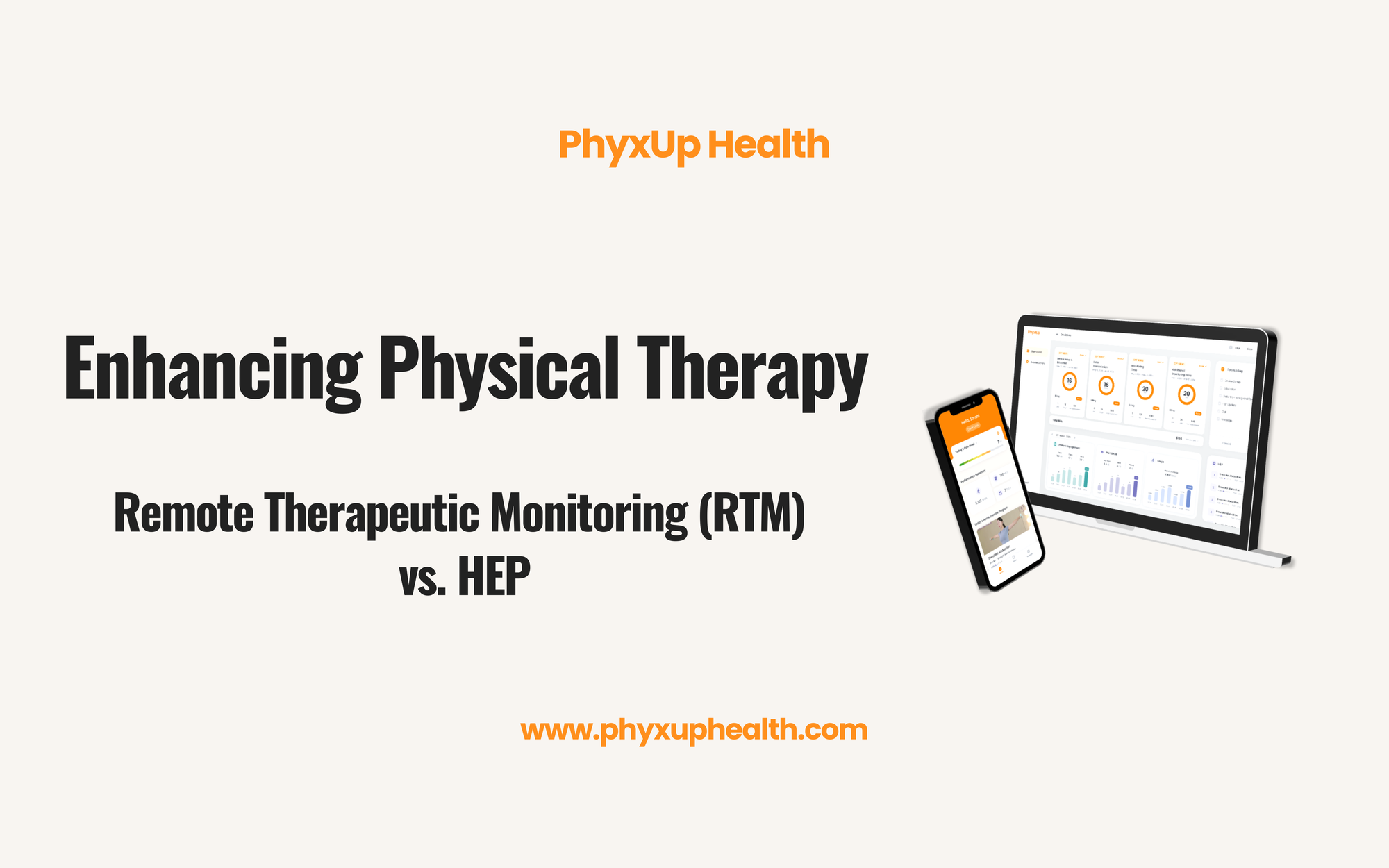Understanding the Difference Between HEP and RTM in Physical Therapy

In physical therapy, two essential tools help improve patient recovery and clinic efficiency: Home Exercise Programs (HEP) and Remote Therapeutic Monitoring (RTM). While both focus on patient care, they offer different approaches and benefits. Understanding these differences can help physical therapy clinics provide better care and create new revenue opportunities.
What is Home Exercise Program?
A Home Exercise Program (HEP) is a set of exercises assigned by physical therapists for patients to perform at home. The goal is to help patients continue their rehabilitation between in-person sessions. Traditionally, HEPs are given as printed instructions or visual guides (such as pictures or diagrams). However, many patients forget to follow them consistently, misplace their instructions, or perform exercises incorrectly. Digital solutions have attempted to improve adherence, but they still lack comprehensive tracking and engagement features.
Benefits of HEP:
- Encourages continued rehab: Helps patients stay active between sessions.
- Easy to implement: Can be shared via printouts or simple digital tools.
- Low-cost solution: No additional technology investment required.
Limitations of HEP:
- No tracking: Therapists cannot monitor patient progress in real time.
- Lack of feedback: If a patient struggles with an exercise, the therapist may not know until the next visit.
- Low compliance: Without reminders or accountability, patients may not follow their HEP properly.
- No reimbursement: Clinics cannot bill for HEP-related services.
What is Remote Therapeutic Monitoring?
Remote Therapeutic Monitoring (RTM) goes beyond traditional HEP by providing real-time tracking and patient engagement. RTM uses digital tools, such as mobile apps, to monitor patient progress, record symptoms, and communicate with therapists. This technology allows therapists to track patient adherence, adjust treatment plans remotely, and improve patient outcomes.
Key Features of RTM:
- Real-time data tracking: Patients log their progress, pain levels, and symptoms.
- Remote communication: Therapists receive updates and can provide immediate feedback.
- Billing opportunities: Clinics can bill for RTM services using specific CPT codes.
- Better compliance: Patients receive reminders and engagement features.
- Improved clinical decision-making: Data-driven insights help optimize treatment plans.
Key Differences Between HEP and RTM
| Feature | HEP (Home Exercise Program) | RTM (Remote Therapeutic Monitoring) |
|---|---|---|
| Function | Provides home exercises | Provides exercises + real-time tracking |
| Patient Interaction | Patients follow instructions independently | Patients log progress and receive therapist feedback |
| Data Tracking | No tracking available | Tracks progress, symptoms, and compliance |
| Real-Time Adjustments | No updates until the next visit | Therapists can adjust treatment remotely |
| Billing & Revenue | No billing options | Reimbursable through CPT codes (98975, 98977, 98980, 98981) |
| Technology | Printed or digital instructions | App-based with data submission and analysis |
| Compliance Support | Patient adherence varies | Automated reminders improve compliance |
| Scalability | Limited to clinic capacity | Expands clinic reach with remote services |
Why RTM is a Game-Changer for Physical Therapy
RTM is revolutionizing physical therapy by integrating real-time data tracking and remote monitoring. Here’s why more clinics are adopting RTM:
1. Improved Patient Outcomes
- RTM helps therapists monitor patient adherence and progress.
- Therapists can adjust treatment plans based on real-time data.
- Patients receive reminders and feedback, increasing compliance.
2. Increased Patient Engagement
- Patients are actively involved in their recovery process.
- They can communicate concerns without waiting for in-person visits.
- RTM creates a stronger therapist-patient connection.
3. New Revenue Opportunities for Clinics
- RTM services are reimbursable under new CPT codes.
- Clinics can generate additional revenue without increasing in-person visits.
- Efficient documentation reduces administrative workload.
CPT Codes for RTM Reimbursement
Physical therapy clinics can bill for RTM services using the following CPT codes:
- 98975 – Initial setup and patient education
- 98977 – Data transmission for musculoskeletal monitoring
- 98980 – First 20 minutes of therapist monitoring and management per month
- 98981 – Additional 20 minutes of monitoring per month
By leveraging these codes, clinics can optimize revenue while enhancing patient care.
How RTM Benefits Physical Therapy Clinics
Beyond improved patient outcomes, RTM has a direct impact on clinic operations and revenue.
1. Enhances Operational Efficiency
- Reduces administrative burden by automating progress tracking.
- Helps therapists focus more on clinical care rather than paperwork.
- Enhances workflow by integrating digital monitoring tools.
2. Expands Care Beyond the Clinic
- Enables therapists to monitor patients recovering at home.
- Reduces unnecessary in-person visits while maintaining high-quality care.
- Offers support for patients who struggle with adherence.
3. Creates a Competitive Advantage
- Attracts tech-savvy patients who prefer digital health solutions.
- Positions clinics as leaders in modern, data-driven physical therapy.
- Differentiates services from competitors relying solely on HEP.
4. Enhancing Patient Accountability
- Patients are more likely to follow their exercise plans when they know their therapist is tracking their progress.
- Digital reminders help maintain consistency and prevent missed sessions.
5. Reducing Readmissions and Injuries
- Early detection of complications helps prevent setbacks in recovery.
- Therapists can intervene before minor issues turn into major problems.
6. Supporting Value-Based Care Models
- RTM aligns with healthcare trends that focus on patient outcomes rather than visit volume.
- Clinics can improve care quality while maintaining financial stability.
The Future of Physical Therapy with RTM
As digital health solutions continue to evolve, RTM is becoming an essential tool for modern physical therapy clinics. It improves patient adherence, streamlines communication, and creates sustainable revenue opportunities. By integrating RTM, clinics can provide high-quality care while optimizing operations. Clinics that embrace RTM will be better equipped to meet the changing needs of patients and insurance providers while increasing profitability.
Why Now is the Right Time to Implement RTM
With increasing healthcare digitization and reimbursement opportunities, RTM adoption is growing rapidly. Clinics that embrace this technology can enhance patient care, increase revenue, and stay ahead of industry trends. Now is the time to integrate RTM and future-proof your clinic for long-term success. By leveraging RTM, clinics can ensure better outcomes for patients while optimizing their own operations for sustained growth and profitability.
Learn More About RTM for Your Clinic
If you want to improve patient engagement, track progress more effectively, and maximize clinic revenue, RTM is the solution. Visit PhyxUp Health to learn how our platform can help your clinic implement RTM efficiently and enhance patient care.
